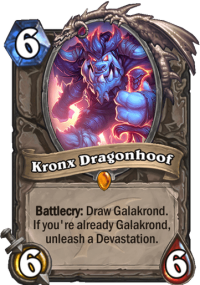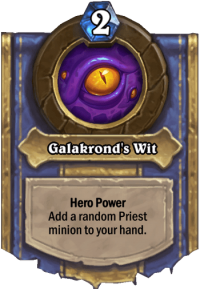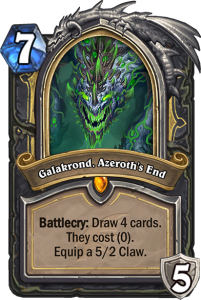The Descent of Dragons is upon us, and with it the most powerful and ancient dragon of all – Galakrond!
To fight the pesky League of Explores, all five E.V.I.L. classes received their very own Galakrond Hero card. Together with the new Invoke mechanic, these classes can worship the progenitor of all dragons and benefit from his strength.
Some of these new Hero cards will support existing class archetypes while others surely will ignite new ways to play certain classes. We will take a look at the basics of Galakrond decks as well as five unique Descent of Dragons theorycrafts for each E.V.I.L. class!
Basics of Galakrond Decks
First off, let us revisit the basic synergy between Galakrond Hero cards and the Invoke mechanic.
All five Galakrond versions work just like any other Hero card. However, similar to C’thun back in Whispers of the Old Gods, these Hero cards can be upgraded with the help of Invoke cards. Every class has one basic version and two upgraded versions.
If you invoke twice, you will upgrade it once; if you invoke twice again, Galakrond will be upgraded one more time to its final version.
No matter if you have played Galakrond or not; as long as it is in your hand, deck or already replaced your Hero, Invoke cards will always trigger its Hero Power (which you can activate just like regular Hero Power once you become Galakrond, of course).

And while all Galakrond versions have their own powerful Battlecry effects, it turns out that building Galakrond decks mostly revolves around the power and synergy of its Hero Power that players trigger through Invoke cards.
Besides Galakrond and the numerous Invoke cards, Kronx Dragonhoof turns out to be a key piece for successfully theorycrafting Galakrond decks.
As it turns out the four different Devastation effects all have their place in every single Galakrond deck we’ve been putting together, no matter if Aggro, Tempo, Token or Control.
Besides that, drawing the 7-cost Galakrond on curve thanks to the 6-cost Kronx Dragonhoof has its upsides as well, which is why he should be featured in every single Galakrond deck.
Priest

Priest pessimists claim that the Battlecry effect of Galakrond, Azeroth’s End is a mediocre one compared to other Galakrond effects.
But those people don’t remember Shadowreaper Anduin. Looking at the limited numbers of minions destroyed in its final form without the attack value restriction, we can talk about a pretty similar effect, which shows the true potential of Galakrond’s Battlecry effect in the later stages of your average Priest game.
Besides that, this effect does exactly what the deck tries to achieve: Pure control. And that control is used to generate infinite value thanks to Galakrond’s Wit, Galakrond’s Priest Hero power.
Adding a random Priest minion one at a time to your hand may sound a bit underwhelming at first; however, your average Priest minion will cost 4 to 5 mana and have a decent amount of stats. And not only that: It adds a ton of versatility and survivability to your toolkit.
Getting full use out of Galakrond’s Wit requires the highest amount of control tools. Mass Hysteria and Plague of Death will do the trick against complex mid and late game, while Depth Charge will most certainly carry almost all DoD control archetypes into the safe harbour called mid game.
All that combines greatly with a lot of high-value dragons starting on turn 4. May it be classics like Twilight Drake or Brightwing, or new powerhouses like Fate Weaver and Chronobreaker; this version of Control Priest should reach late game without too many problems.
And that is where the fun begins for this list: Murozond the Infinite and Dragon Breeder lie in wait for your opponent’s power turns, while Princess Princess Talanji already counts the number of randomly generated minions in your hand.
Rogue

Good news everyone – both Invoke cards in Rogue’s toolkit are spells, so guess what? The minion base of this Galakrond Rogue list can basically be built as new iteration of Lackey Rogue!
With new cards like Shield of Galakrond and Seal Fate, Galakrond looks to take more control of the early and mid game, only to build up insane hands overflowing with Lackey cards in the later stages of the match. Praise Galakrond! may be one of the strongest Invoke cards of the set, providing a cheap yet effective board buff including a Lackey for free.
Spirit of the Shark serves as the main value generation engine, as it not only buffs Lackey generation, but Invoke effects and Galakrond’s Battlecry effect as well!
On top reigns Heistbaron Togwaggle and his lieutenant EVIL Miscreant, waiting to command their Lackey army, just like they used to during their first battle after the release of Rise of Shadows.
As already said, this list relies on Galakrond’s Hero Power – which doesn’t mean that its Battlecry effect is useless. However, in this case of Galakrond Rogue, it’s basically the cherry on top!
Shaman

Yes, the majority of the community has seen enough decent Shaman decks this year – but wait, there is more!
Shaman’s Galakrond Hero card as well as its hero power seems to be a versatile to addition to many different archetypes; but after taking a look at the board-centric Galakrond Hero Power, Token Shaman could provide the best card base.
One reason for that are Shaman’s great Invoke cards – Invocation of Frost on the one side is basically a Glacial Shard on steroids; Corrupt Elementalist brings a total of 12 stats and three tokens on the board, while serving as a prime target for Mutate.
In the mid game, all those tokens can easily be buffed by what looks to be Shaman’s strongest card of the set: Storm's Wrath. Together with Surging Tempest early game domination is guaranteed. As always, the same goes for late game and Bloodlust.
Besides Token Shaman classics like Thunderhead and Vessina, a very special minion also made this list: Shu'ma! This gargantuan piece of Old Gods creation may be one of the most underrated cards of the set, and we will see it have its place in token-based decks all over the game.
Warlock

Another board-centric deck that uses Galakrond is Galakrond Zoo Warlock. Similar to our Rogue list, this iteration of Zoolock tries to make the most use out of Galakrond’s Malice, Warlock’s Galakrond Hero Power.
In terms of Invoke cards, Warlock only really offers one decent option, and that is Fiendish Rites. In itself it’s basically two 2/1 minions for 3 mana, which doesn’t feel too overwhelming. However, the board-wide attack value buff adds a whole new level to Zoolock plays, just because you almost always will have other minions on the board by turn 3. Dragonblight Cultist played on an empty board is a 3/1, but the fact that it stays on 1 health makes it more of a “token producer” than anything.
Another reason why we play this mediocre minion is Veiled Worshipper. Zoolock players know how important card draw can become, so trying to pull of two Invoke effects as soon as possible seems imperative when playing this list. That is why we include Devoted Maniac, another mediocre minion that only gets a little better because it produces two imps.
Galakrond, the Wretched‘s Battlecry effect, in comparison to other class Galakrond cards, can make or break the game. Similar to Bloodreaver Gul'dan, summoning up to four random demons already sounds quite strong, and the demon tribe pool has improved by quite a bit this Standard year.
Warrior

Last but not least we managed to come up with a great way to make Galakrond Warrior work. Thanks to Rise of Shadows, Aggro Warrior managed to rise up once again, and that could happen with Galakrand Aggro Warrior as well.
The core list looks like your average Saviors of Uldum iteration of this archetype; however, Warrior’s Invoke cards bring in the spice: First there is Ritual Chopper, which looks a whole lot like an ancient weapon called Fiery War Axe, and it does exactly the same at least on one of the two turns where you can attack with it.
Warrior’s second Invoke card Awaken! doesn’t look as strong; however, this deck played often played one copy of Warpath in the past, and one more mana for a +3 attack with your hero could actually make the cut in the long term.
Scion of Ruin certainly will impact the success of Galakrond Aggro Warrior. A 3-mana 3/2 Rush minion on its own can perform well; three copies of it turn into a legit mid game threat. Faceless Corruptor complements the Rush package and shares great synergy with staple cards like Livewire Lance.
Ultimately, Galakrond, the Unbreakable‘s role in this deck is obvious: Give good Rush minions big stats! That and its Hero Power through Invoke effects could give Galakrond Aggro Warrior just enough juice to overcome its core problems like early board control and minion flooding.
Leave a Reply
You must be logged in to post a comment.





















































































I noticed for your warrior deck you can only invoke galakrond up to 3 times. Would the deck lose too much board control by adding a couple more invoke cards to take advantage of a fully upgraded galakrond? Four +4/4 minions and a 5/2 claw seems pretty strong to me in an aggro deck. And you can make the claw an 8/2 with the hero power.
I really like your token-based Gal Shaman deck. Unfortunately, I think the battlecry/quest variant with Shudderwok will be what dominates the meta– it just adds so much value to an already powerful tempo deck. which I think is sad because its not that different from pre DitT meta.
That could become the case, yes. However, I think that Galakrond value may just be enough to get somewhere close to Tier 2.